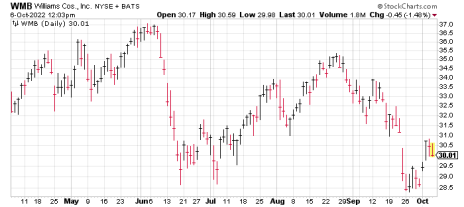This is a tough time to be an investor. We’re already in a bear market. And with inflation, a hawkish Fed, and recession still looming things might get worse before they get better. Where’s the best place to put your money in such a predicament? Cash? Value? Dividend stocks?
While it makes sense to raise some cash in order to limit risk and have some dry powder to take advantage of low prices ahead of the next bull market, it doesn’t make sense for a lot of your investable money. Money markets still pay very little. And market timing seldom works.
It sounds like a good idea to wait in cash until things improve. But when is that precisely, and how will you know? In most cases investors miss the boat and don’t get back into the market until much of the easy upside is gone, negating the advantage of investing on the cheap. Plus, cash has been the worst-performing asset class in just about every measurable period over the last forty years.
The better answer is dividends.
[text_ad]
Since 1930 dividends have accounted for 40% of total market returns. And dividend stocks have done so with much less volatility than the overall market. But that’s just the overall average. During sideways and down-market periods dividends account for most of the total market return. In problematic decades, dividends have almost completely offset market price declines.
It’s true that dividend stocks can still fall in a down market. But the market may not fall further, and the long-term trend for the market is higher. History clearly shows that bear markets are the best time to get in cheap ahead of the next bull market. Meanwhile, dividends provide an income and less volatility while you wait.
Consider the results for this troubled year in the market so far. The S&P 500 is down over 20% YTD. But the iShares Select Dividend ETF (DVY), which represents only the dividend-paying stocks on the same index, has returned a far more tolerable -4% YTD.
It’s also worth noting the superior historical performance of dividend stocks during times of inflation. During the three decades where inflation averaged 5% or higher (the 1940s, ‘70s, and ‘80s), dividends contributed 56% of market returns. In the higher-inflation decades of the ’40s and ’70s, dividends contributed 67% and 73% of market returns respectively.
Of course, those returns are for dividend stocks in general. Well-selected dividend payers can fare far better than the averages. Here are two very promising stocks right now.
2 Attractive Dividend Stocks to Consider
Medical Properties Trust, Inc. (NYSE: MPW)
Yield: 10.5%
Medical Properties Trust is a healthcare Real Estate Investment Trust (REIT) that invests in hospitals and clinical spaces and leases them back to healthcare providers. It rents 447 properties in 10 countries and is the largest company to focus exclusively on hospital facilities with more than $1.6 billion in annual revenues.
MPT buys properties from hospital operators and leases the property back to them. The arrangement provides operators with cash to fund facility improvements, make technological upgrades, and various other investments in operations. MPT gets a steady and predictable cash flow whereby operators are responsible for costs and upgrades.
The stock has outperformed its peers over the last three-, five- and ten-year periods despite recent weakness. A recent decline makes MPW cheap and high yielding.
The stock price is down more than 50% YTD. The reasons behind the stock plunge are rising interest rates and flat guidance.
Rising interest rates pressure REITs in two ways. First, it makes competing fixed-rate investments more competitive for income investors. Second, it raises the cost of funding for acquisitions and expansions. The former is the more legitimate problem. REITs pay out most of their earnings in the form of dividends and need to borrow money or issue stock to raise money for expansions. Higher rates make expanding more expensive and limit growth.
The higher rates are limiting near-term growth for MPT. The REIT targets $1 billion to $3 billion per year for acquisitions and this year will be near the low end. That limits earnings and dividend growth. But the stock sells at just eight times funds from operations (FFO) compared to about 17 times for its peers and its five-year average. Just making up most of that difference can move the stock price significantly higher.
It’s also timely because hospitals are a very recession-resistant business. And the company has automatic inflation adjustments built into its leases. The 10.5% yield combined with just a little appreciation can provide a double-digit return in a troubled market. In a year where the market index is down 20% already and things could get worse, it’s time to look to positions that can be a single or a double. And MPW fits the bill while providing a high income.
Williams Companies Inc. (WMB)
Yield: 5.7%
Midstream energy companies are in the sweet spot of the current environment. Unlike most energy companies, revenues are not dependent on volatile commodity prices that can fall in a recession. These companies just collect fees for the transport and service of oil and gas.
Most midstream stocks also sell at a compelling valuation and pay some of the highest yields on the market in an industry with very favorable dynamics right now. Midstream energy companies are uniquely positioned to thrive in an environment of recession and inflation while providing a great income at the same time.
Williams is an American midstream energy company involved in the transmission, gathering, processing and storage of natural gas. It operates the large Transco and Northwest pipeline systems that transport gas in densely populated areas from the Gulf to the East Coast. Roughly 30% of the natural gas in the U.S. moves through its systems.
A huge tailwind is that there is a rise in natural gas demand in all its sectors. There continues to be a growing need for secure and reliable supplies amid high prices, geopolitical volatility, and climate concerns. In fact, Williams’ earnings continued to rise right through the heart of the pandemic lockdowns, one of the worst periods for the industry ever. The current situation makes the earnings especially recession resistant. Plus, there are automatic inflation adjustments in its long-term contracts.
Williams also has the advantage of having a large and well-established network. Regulators tend to be much more lenient for expansions than new projects, favoring established players. Williams has a well-positioned network that allows it to invest in high-return growth projects with minimal regulatory hurdles.
The company currently has $1.5 billion invested in six projects that will boost the bottom line over the next several years. That should keep the growth pump primed. WMB has been a strong performer in this market so far. But it still sells at a reasonable valuation with a dividend backed by reliable revenues and one of the lowest payout ratios of its peers.
To learn more about the other dividend stocks I’m bullish on, subscribe to Cabot Dividend Investor today!
[author_ad]



